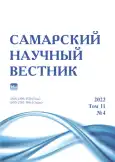Гендерная идентификация пингвинов Гумбольдта на основе морфометрических признаков
- Авторы: Сабуцкая М.А.1,2
-
Учреждения:
- Приморский океанариум – филиал Национального научного центра морской биологии им. А.В. Жирмунского ДВО РАН
- Дальневосточный федеральный университет
- Выпуск: Том 11, № 4 (2022)
- Страницы: 110-114
- Раздел: Биологические науки
- URL: https://journal-vniispk.ru/2309-4370/article/view/133226
- DOI: https://doi.org/10.55355/snv2022114116
- ID: 133226
Цитировать
Полный текст
Аннотация
В Приморском океанариуме содержится популяция пингвинов Гумбольдта, насчитывающая 32 особи. На данный момент перед сотрудниками отдела орнитологии стоит проблема определения пола 18 появившихся в океанариуме птенцов. Самки и самцы половозрелых пингвинов Гумбольдта не имеют значительных различий в окраске перьев, поэтому достоверная гендерная идентификация методом прямого наблюдения невозможна. Наиболее достоверные ультразвуковой и генетический методы являются затруднительными, поскольку требуют не только специального оборудования, реактивов и квалифицированных специалистов, но и способны спровоцировать стресс, опасный для здоровья птиц. Определение пола по морфометрическим показателям для птиц, содержащихся в неволе, является более предпочтительным, поскольку эта процедура не инвазивная, не несет необходимости использования специального оборудования и не требует особых навыков специалиста. В нашей работе проведен статистический анализ данных измерений длины клюва в 3-х вариациях и длины дорсальной части крыла и веса у самок и самцов исследуемой группы пингвинов Гумбольдта, содержащихся в Приморском океанариуме. Впервые нами в анализ была добавлена длина клюва от ноздри, которую ранее не учитывали. Выявлено, что применение одновременно 4-х признаков в анализе не демонстрирует достоверной корреляции с полом птицы, а значит, не подходит для гендерной идентификации пингвинов. Наиболее состоятельными для корреляционного анализа признаками оказались длина клюва и длина крыла. При сопоставлении этих морфометрических характеристик наблюдалась максимальная группировка птиц по полу внутри исследуемой группы.
Полный текст
Открыть статью на сайте журналаОб авторах
Мирослава Алексеевна Сабуцкая
Приморский океанариум – филиал Национального научного центра морской биологии им. А.В. Жирмунского ДВО РАН; Дальневосточный федеральный университет
Автор, ответственный за переписку.
Email: sabutskaya89@mail.ru
ведущий специалист отдела орнитологии, магистрант института наук о жизни и биомедицины
Россия, Владивосток; ВладивостокСписок литературы
- Wallace R.S., Dubach J., Michaels M.G., Keuler N.S., Diebold E.D., Grzybowski K., Teare J.A., Willis M.J. Morphometric determination of gender in adult Humboldt penguins (Spheniscus humboldti) // Waterbirds. 2008. Vol. 31, iss. 3. P. 448–453. doi: 10.1675/1524-4695-31.3.448.
- Merritt K., King Nancy E. Behavioral sex differences and activity patterns of captive Humboldt penguins (Spheniscus humboldti) // Zoo Biology. 1987. Vol. 6, iss. 2. P. 129–138.
- Scholten C.J. Breeding biology of the Humboldt penguin Spheniscus humboldti at Emmen Zoo // International Zoo Yearbook. 1987. Vol. 26, iss. 1. P. 198–204. doi: 10.1111/j.1748-1090.1987.tb03158.x.
- Romanov M.N., Betuel A.M., Chemnick L.G., Ryder O.A., Kulibaba R.O., Tereshchenko O.V., Payne W.S., Delekta Ph.C., Dodgson J.B., Tuttle E.M., Gonser R.A. Widely applicable PCR-markers for sex identification in birds // Russian Journal of Genetics. 2019. Vol. 55, iss. 2. P. 220–231. doi: 10.1134/s1022795419020121.
- Dubach J. Gender determination in captive and wild species of penguin // Penguin Conservation. 1996. Vol. 9. P. 14–16.
- Hull C.L. Morphometric indices for sexing adult Royal Eudyptes schlegeli and Rockhopper E. chrysocome penguins at Macquarie Island // Marine Ornithology. 1996. Vol. 24. P. 23–27.
- Renner M., Davis L.S. Sexing little penguins Eudyptula minor from Cook Strait, New Zealand using discriminant function analysis // Emu – Austral Ornithology. 1999. Vol. 99, iss. 1. P. 74–79. doi: 10.1071/mu99009c.
- Scolaro J.A. Sexing fledglings and yearlings of Magellanic penguins by discriminant analysis of morphometric measurements // Colonial Waterbirds. 1987. Vol. 10, iss. 1. P. 50–54. doi: 10.2307/1521230.
- Zavalaga C.B., Paredes R. Sex determination of adult Humboldt penguins using morphometric characters // Journal of Field Ornithology. 1997. Vol. 68, iss. 1. P. 102–112.
- Bertellotti M., Tella J.L., Godoy J.A., Blanco G., Forero M.G., Donazar J.A., Ceballos O. Determining sex of Magellanic penguins using molecular procedures and discriminant functions // Waterbirds. 2002. Vol. 25, iss. 4. P. 479–484. doi: 10.1675/1524-4695(2002)025[0479:dsompu]2.0.co;2.
- Boersma P.D., Davies E.M. Sexing monomorphic birds by vent measurements // Auk. 1987. Vol. 104. P. 779–783.
- Scolaro J.A., Hall M.A., Ximenez I.M. The Magellanic penguin (Spheniscus magellanicus): sexing adults by discriminant analysis of morphometric characters // Auk. 1983. Vol. 100. P. 221–224.
- Gales R.P. Sexing adult Blue penguins by external measurements // Notornis. 1988. № 35. P. 71–75.
- Pennington V. The use of radioimmunoassays to determine gender in Humboldt penguins Spheniscus humboldti // Penguin Conservation. 1996. Vol. 9. P. 16–18.
- Samour H.J., Stevenson M., Knight J.A., Lawrie A.J. Sexing penguins by cloacal examination // Veterinary Record. 1983. Vol. 113, iss. 4. P. 84–85. doi: 10.1136/vr.113.4.84.
- McDonald S. Surgical sexing of birds by laparoscopy // California Veterinarian. 1982. Vol. 5. P. 16–22.
- Hildebrandt T., Pitra C., Sommer P., Pinkowski M. Sex identification in birds of prey by ultrasonography // Journal of Zoo and Wildlife Medicine. 1995. Vol. 26, № 3. P. 367–376.
- Griffiths R., Double M.C., Orr K., Dawson R.J.Q. A DNA test to sex most birds // Molecular Ecology. 1998. Vol. 7. P. 1071–1075.
- Purwaningrum M., Nugroho A., Asvan M., Karyanti K., Alviyanto B., Kusuma R., Haryanto A. Molecular techniques for sex identification of captive birds // Veterinary World № 12 (9). P. 1506–1513. doi: 10.14202/vetworld.2019.1506-1513.
- Forero M.G., Tella J.L., Donazar J.A., Blanco G., Bertellotti M., Ceballos O. Phenotypic assortative mating and within-pair sexual dimorphism and its influence on breeding success and offspring quality in Magellanic penguins // Canadian Journal of Zoology. 2001. Vol. 79, iss. 8. P. 1414–1422. doi: 10.1139/z01-088.
- Agnew D.J., Kerry K.R. Sexual dimorphism in penguins // The penguins / eds P.N.I. Normar, P. Reilly. Surrey: Beatty and Sons, 1995. P. 299–318.
- Alvin N.S., Darby J.T., Lambert D.M. The use of morphometric measurements to sex Yellow-eyed penguins // Waterbirds. 2004. Vol. 27, iss. 1. P. 96–101.
Дополнительные файлы









